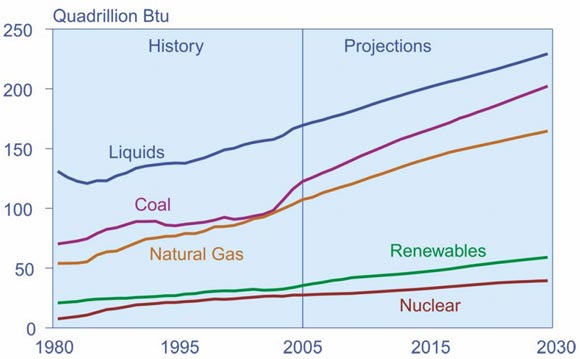ARCHIVED - Global and Canadian Context for Energy Demand Analysis - Energy Brief
This page has been archived on the Web
Information identified as archived is provided for reference, research or recordkeeping purposes. It is not subject to the Government of Canada Web Standards and has not been altered or updated since it was archived. Please contact us to request a format other than those available.
Global and Canadian Context for Energy Demand Analysis - Energy Brief [PDF 101 KB]

September 2008
Global and Canadian Context for Energy Demand Analysis - Energy Brief
This briefing note introduces an upcoming series of notes on Canada's energy demand. The series will discuss current trends, technology, policy, regulations, and social issues, and will explore opportunities and potential for shifts in energy demand. This first briefing note considers the global and national context of energy demand issues in order to support future detailed study into specific energy demand topics.
Global and Canadian Context
The International Energy Agency (IEA) reference scenario predicts world energy demand could grow as much as 55 per cent by 2030 and potentially double by 2050[1]. The projected growth is not uniform and there are wide regional variances. Collectively, the European Union has experienced a decrease in demand in recent years; at the same time, energy demand in some Asian countries is growing at three times the rate of the world average. Historically, economic growth has been a dominant driver for increased energy consumption, and developing economies such as China and India are predicted to account for 74 per cent of the global demand increase by 2030.
[1] World Energy Outlook. International Energy Agency (IEA), 2007.
In Canada the historical trend of energy demand could be characterized as one of robust growth. By 2030, demand is projected to increase by 35 per cent[2]. Nonetheless, a number of factors are expected to impact energy demand in the future. In the face of drastic price increases, consumers are reducing consumption. In addition, the high cost of energy is stimulating investment in new and clean technology. In the last few years, a number of government initiated energy demand management programs have been launched to address supply, price, and environmental concerns. Energy and environmental policy proposals have been released in all provinces and territories in the last two years. (A complete list of energy programs is available as Appendix 2 of the Briefing Note - Global and Canadian Context for Energy Demand Analysis.
[2] Canada's Energy Future - Reference Case and Scenarios to 2030. National Energy Board, November 2007.
Figure 1 - Global Demand Forecast - Fuel

Source: Energy Information Administration (IEA data), (2007)
The most notable energy demand development at the federal level is based on Canada's Clean Air Regulatory Agenda released under the title Turning the Corner: An Action Plan to Reduce Greenhouse Gases and Air Pollution[3]. A target of 20 per cent reduction in Greenhouse Gases from 2006 levels by 2020 is proposed. Energy demand management and emissions reduction based programs are the major driver of an updated supply and demand analysis. With a number of new federal and provincial programs, the climate change agenda is expected to have a significant impact on Canadian energy demand.
[3] Turning the Corner Plan. Environment Canada, 2007.
Future Analysis
Future energy demand analysis will need to take into account revised energy price forecasts, and the broader range of technology and fuel choice options that compete within these markets. Energy efficiency is considered one of the most accessible resource options; however, year-to-year improvements in efficiency are generally very slight and the evolution of most technological "breakthroughs" is measured in decades. That being said, in the last few years, investment in emerging clean technology has increased remarkably:
- In 2006, $71 billion was invested in renewable energy and energy efficiency. This is up by 43 per cent in one year, and 158 per cent over two years[4].
- Between 2005 and 2006, investment in renewable energy sectors such as technology development, commercialization, and manufacturing firms jumped 140 per cent.[5]
- In the same time period, venture capital and private equity investment jumped 163 per cent.[7]
- World installed solar photovoltaic (PV) capacity grew 62 per cent in 2007.[8]
[4] Global Trends in Sustainable Energy Investment 2007. United Nations Environment Programme, 2007.
[5] ibid
[6]. ibid
[7] Marketbuzz 2008: Annual World Photovoltaic Industry Review. Solarbuzz, 2008.
Globally however, the IEA predicts that our reliance on fossil fuels is not expected to change significantly between now and 2030.[8] Looking forward, indicators which account for both economic efficiency (energy used per unit of economic output) and the types of fuel being used (emissions content per unit of energy) will play a larger role in monitoring energy demand trends.
[8] World Energy Outlook, International Energy Agency (IEA), 2007 Edition
Global issues such as commodity prices and economic growth will likely continue to be the dominant drivers for changes in energy demand in Canada. However, many factors including new technology, policy, regulations, and even changes in consumer attitudes and behaviour on energy use can significantly influence energy demand. These factors all need to be taken into account.
In 2008 and 2009 the NEB will produce a series of Energy Demand briefing notes which will assist in the development of upcoming national energy supply and demand forecasts. In addition, they will help to inform Canadians about energy issues.
- A review of new or proposed codes, standards, and regulations
- Attitudes and behaviour and impact on energy demand
- Update on transportation technology and policy
- A review of major trends and technology shifts in major industrial sectors
- New technology in demand-side management and smart-grid
- A review of new building technology and trends
- Concepts in urban design and its influence on energy demand
- Date modified:
